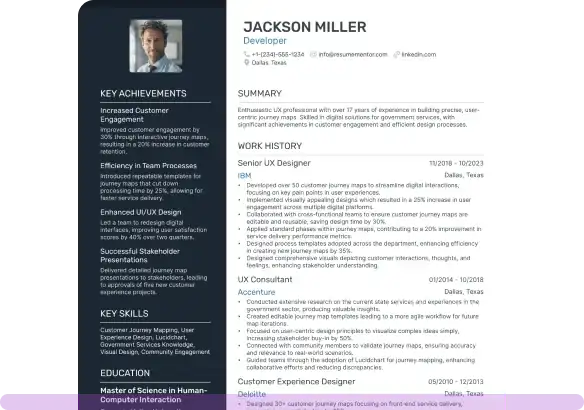Marketing Manager Resume Examples & Writing Tips for 2025

Jul 18, 2024
|
12 min read
Market your way to your next job—read our guide to get started.
Rated by 348 people
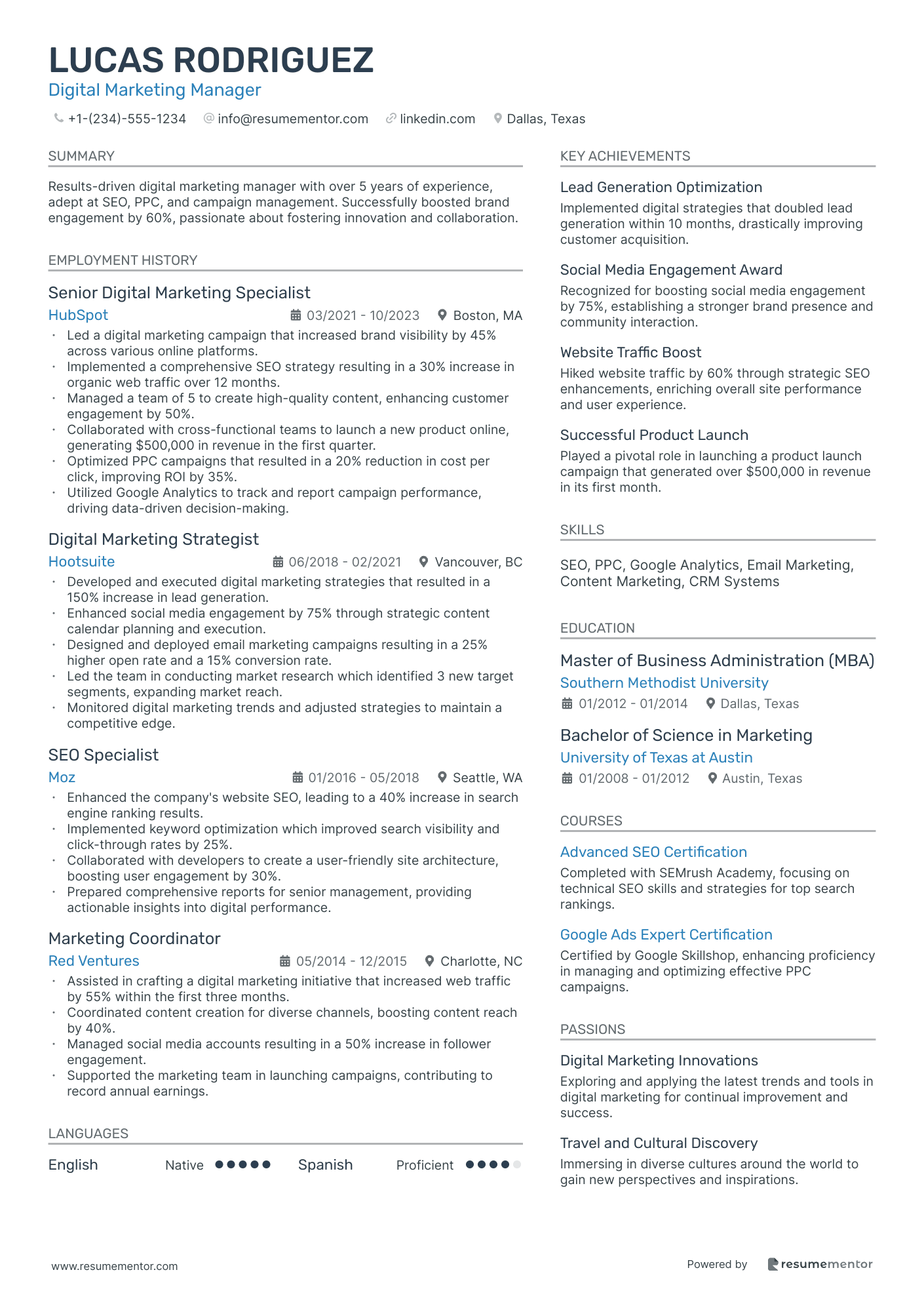
Digital Marketing Manager
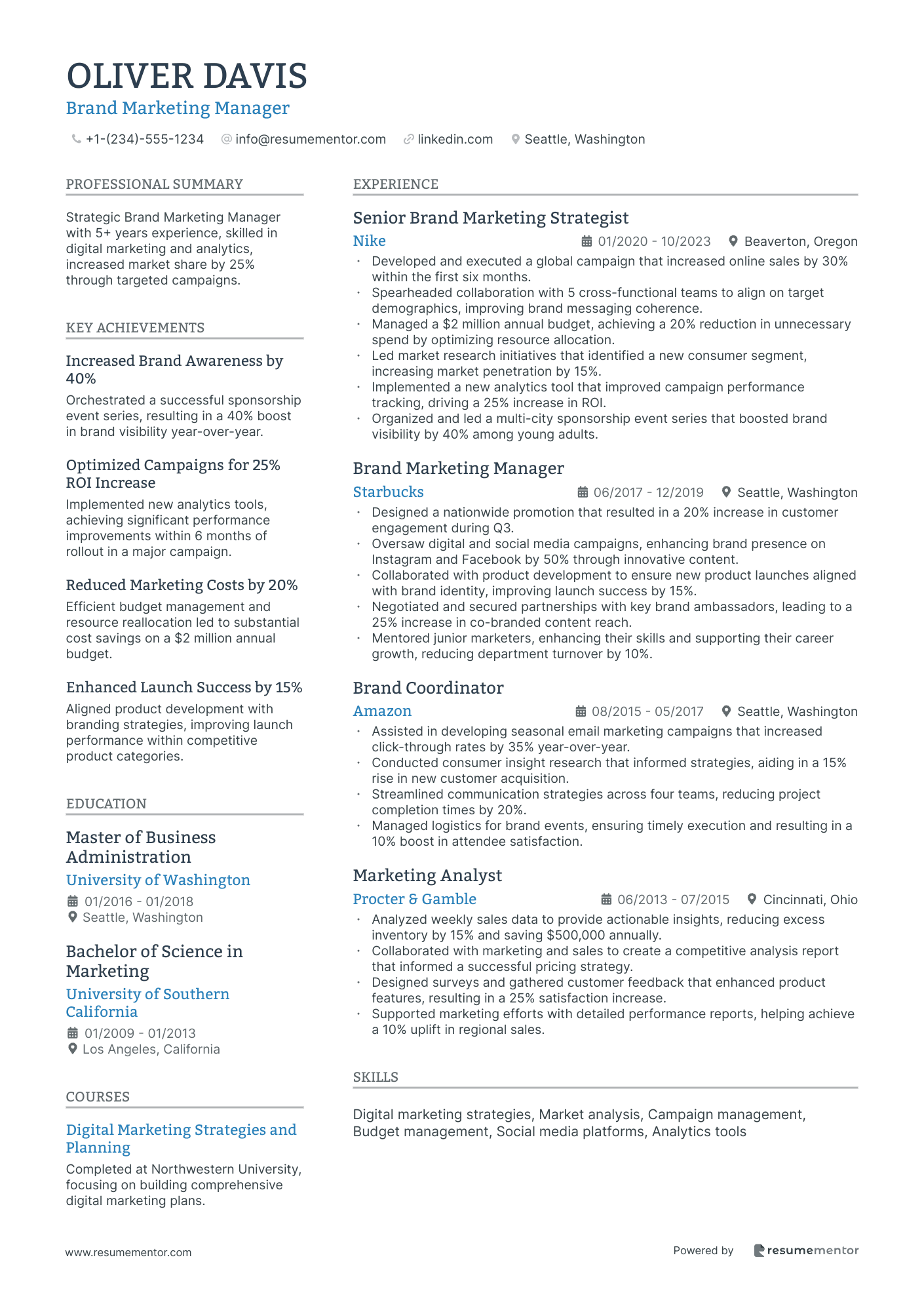
Brand Marketing Manager
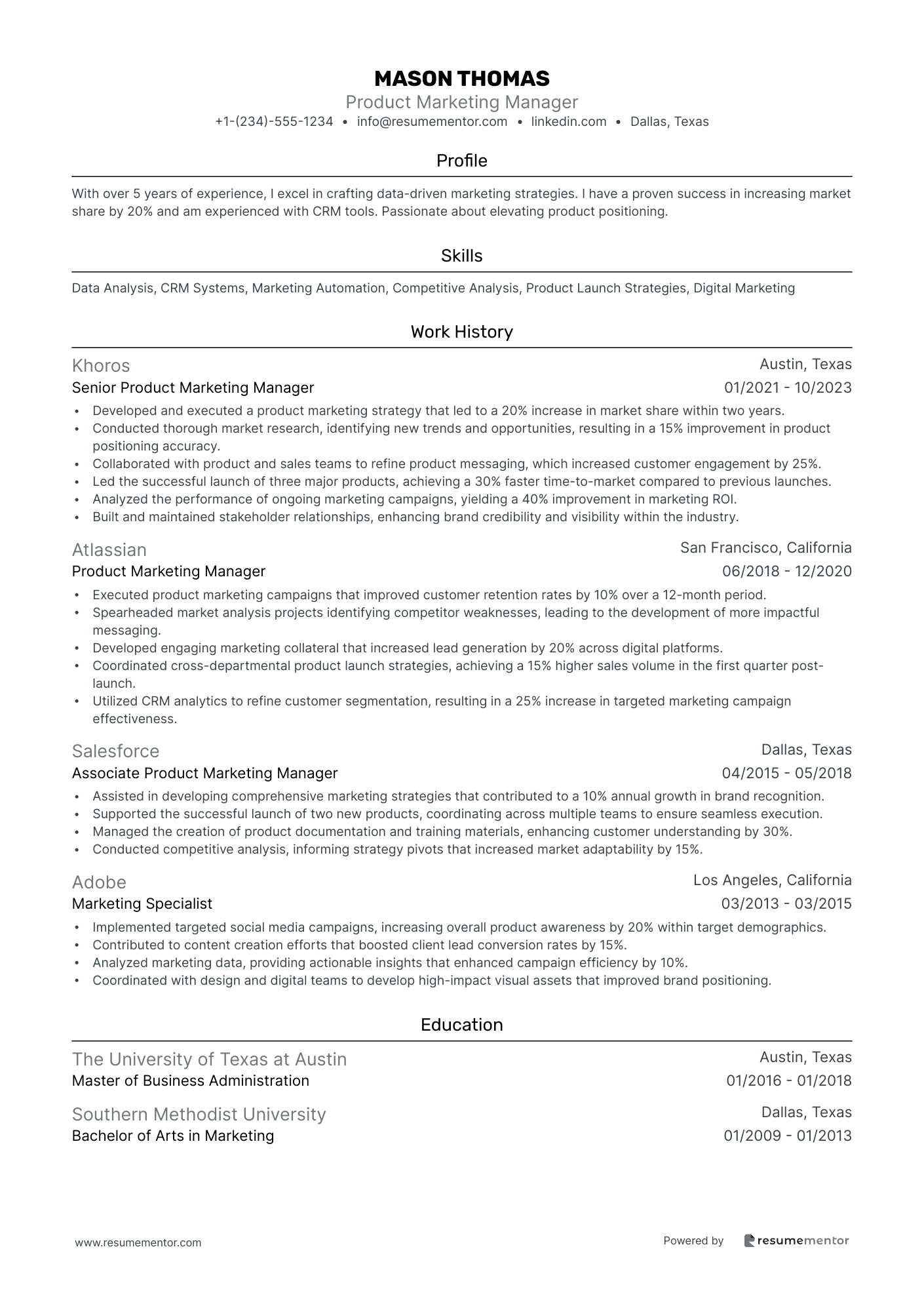
Product Marketing Manager
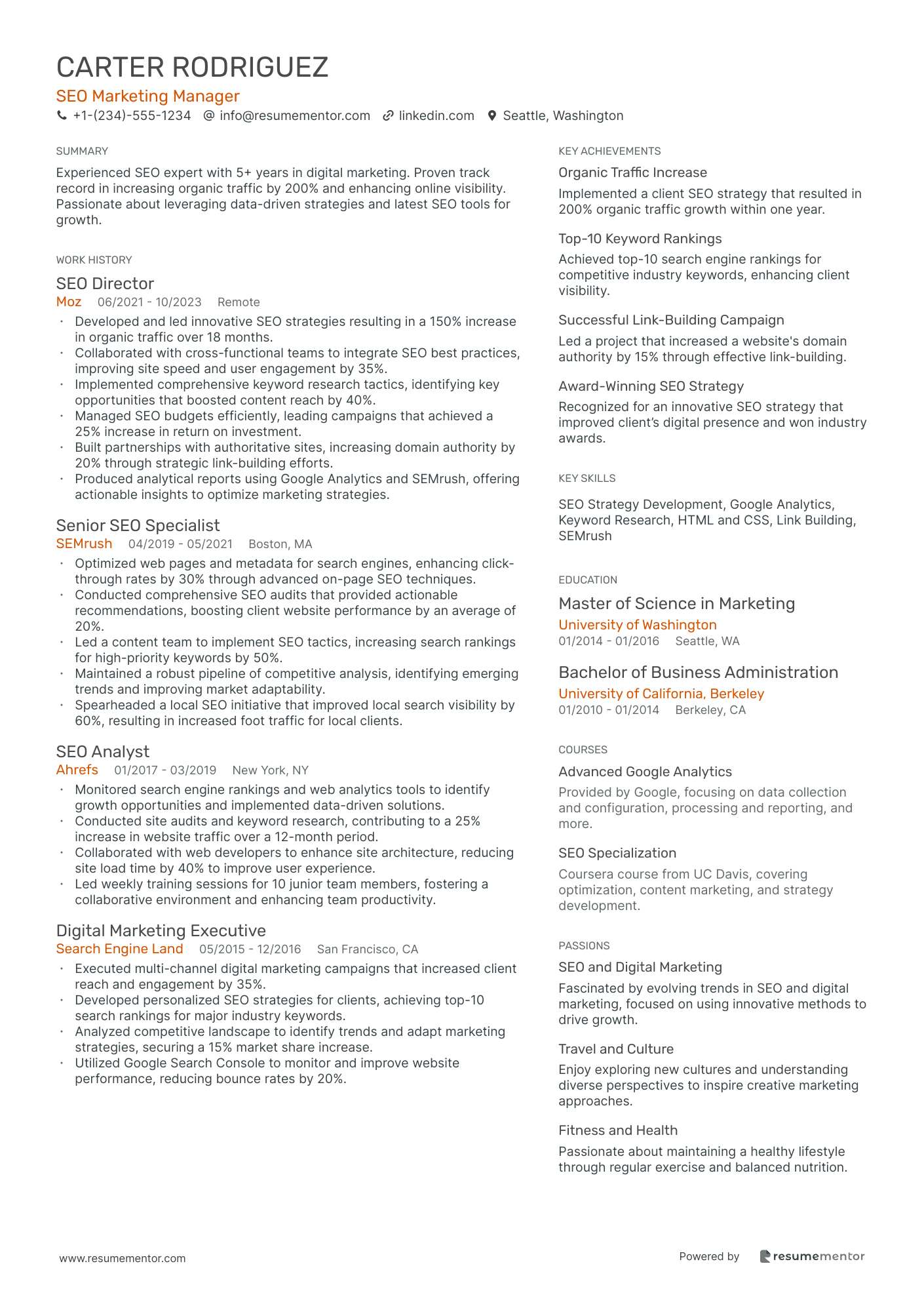
SEO Marketing Manager
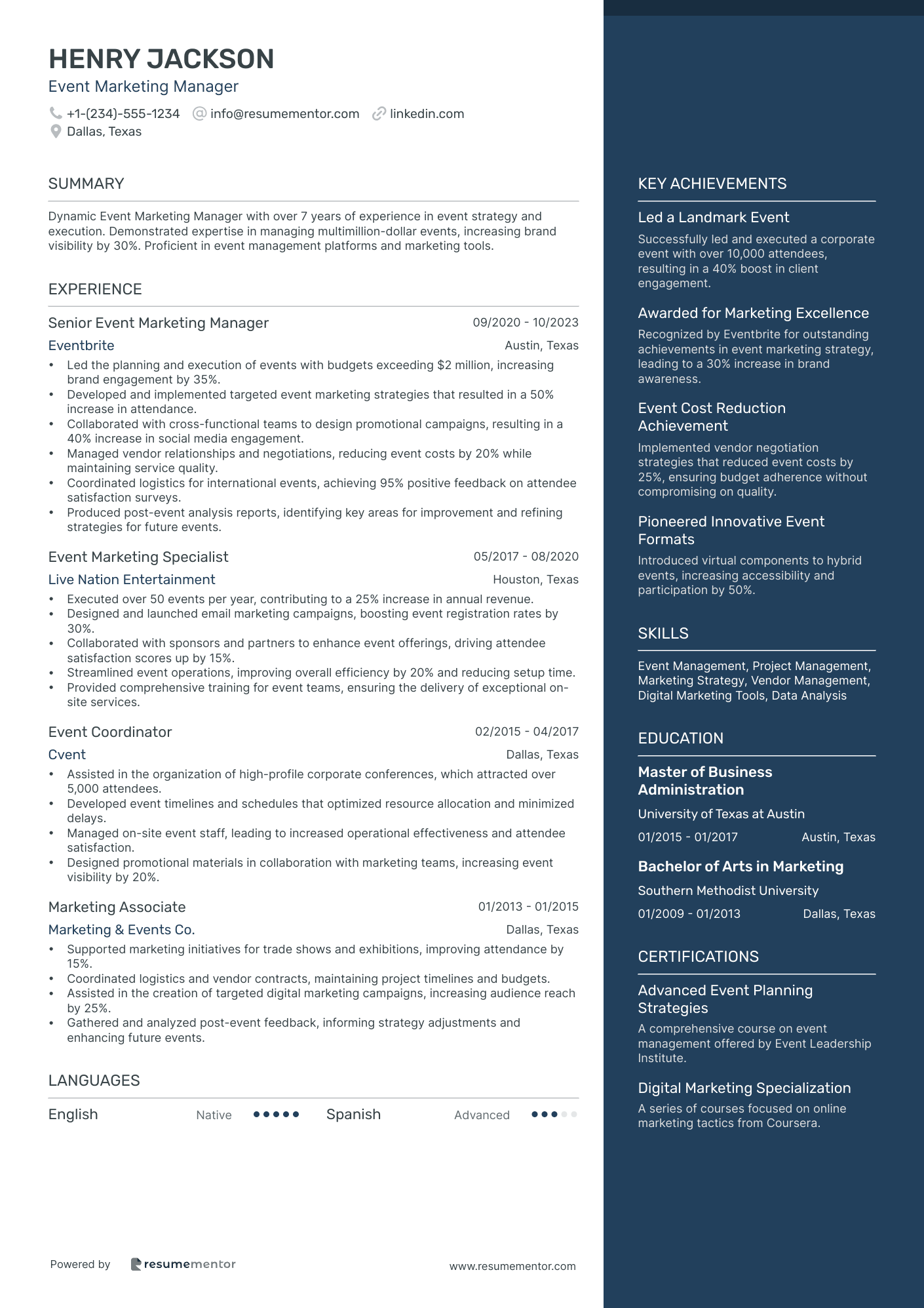
Event Marketing Manager
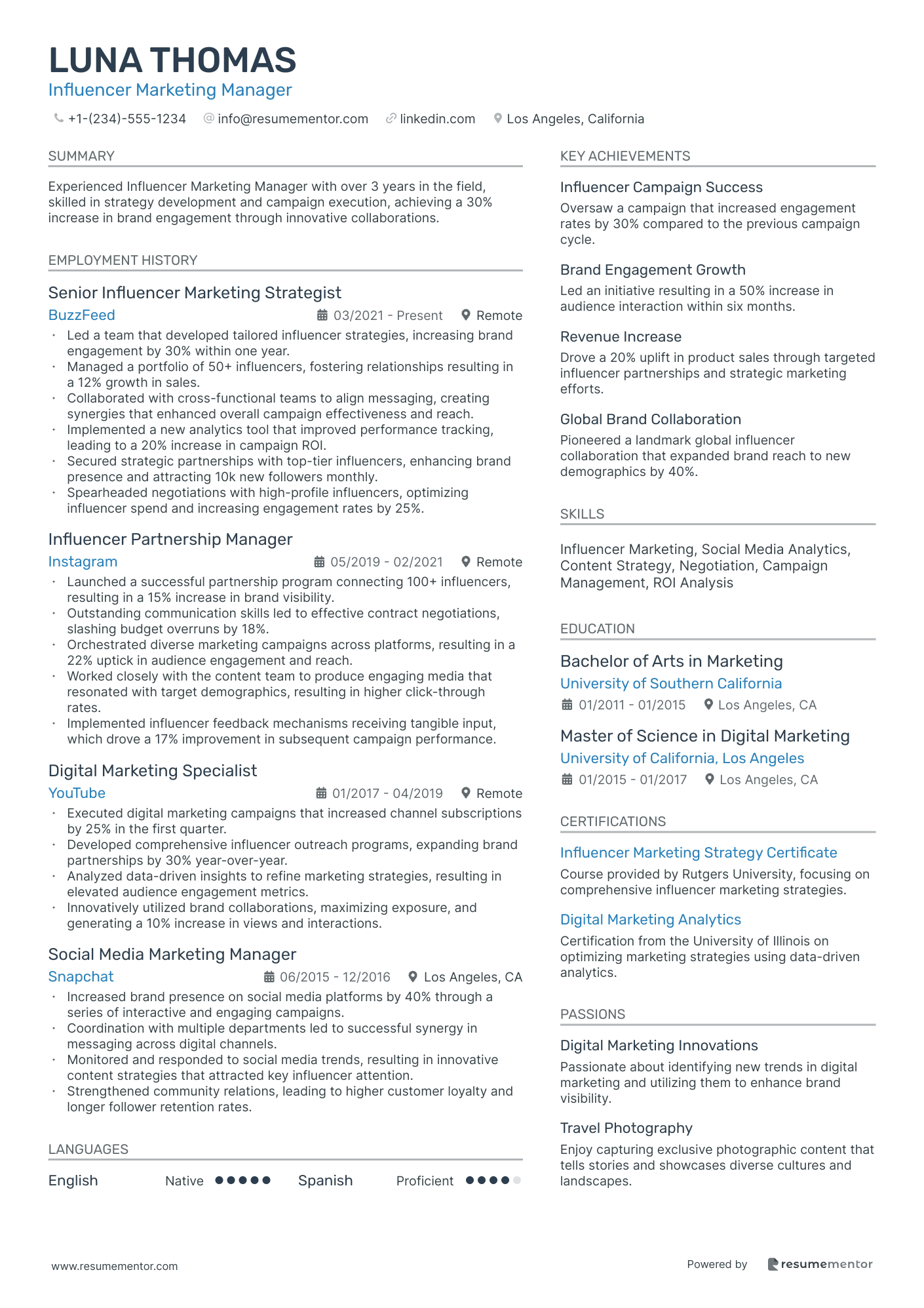
Influencer Marketing Manager

Digital Marketing Manager resume sample
- •Led a digital marketing campaign that increased brand visibility by 45% across various online platforms.
- •Implemented a comprehensive SEO strategy resulting in a 30% increase in organic web traffic over 12 months.
- •Managed a team of 5 to create high-quality content, enhancing customer engagement by 50%.
- •Collaborated with cross-functional teams to launch a new product online, generating $500,000 in revenue in the first quarter.
- •Optimized PPC campaigns that resulted in a 20% reduction in cost per click, improving ROI by 35%.
- •Utilized Google Analytics to track and report campaign performance, driving data-driven decision-making.
- •Developed and executed digital marketing strategies that resulted in a 150% increase in lead generation.
- •Enhanced social media engagement by 75% through strategic content calendar planning and execution.
- •Designed and deployed email marketing campaigns resulting in a 25% higher open rate and a 15% conversion rate.
- •Led the team in conducting market research which identified 3 new target segments, expanding market reach.
- •Monitored digital marketing trends and adjusted strategies to maintain a competitive edge.
- •Enhanced the company's website SEO, leading to a 40% increase in search engine ranking results.
- •Implemented keyword optimization which improved search visibility and click-through rates by 25%.
- •Collaborated with developers to create a user-friendly site architecture, boosting user engagement by 30%.
- •Prepared comprehensive reports for senior management, providing actionable insights into digital performance.
- •Assisted in crafting a digital marketing initiative that increased web traffic by 55% within the first three months.
- •Coordinated content creation for diverse channels, boosting content reach by 40%.
- •Managed social media accounts resulting in a 50% increase in follower engagement.
- •Supported the marketing team in launching campaigns, contributing to record annual earnings.
Brand Marketing Manager resume sample
- •Developed and executed a global campaign that increased online sales by 30% within the first six months.
- •Spearheaded collaboration with 5 cross-functional teams to align on target demographics, improving brand messaging coherence.
- •Managed a $2 million annual budget, achieving a 20% reduction in unnecessary spend by optimizing resource allocation.
- •Led market research initiatives that identified a new consumer segment, increasing market penetration by 15%.
- •Implemented a new analytics tool that improved campaign performance tracking, driving a 25% increase in ROI.
- •Organized and led a multi-city sponsorship event series that boosted brand visibility by 40% among young adults.
- •Designed a nationwide promotion that resulted in a 20% increase in customer engagement during Q3.
- •Oversaw digital and social media campaigns, enhancing brand presence on Instagram and Facebook by 50% through innovative content.
- •Collaborated with product development to ensure new product launches aligned with brand identity, improving launch success by 15%.
- •Negotiated and secured partnerships with key brand ambassadors, leading to a 25% increase in co-branded content reach.
- •Mentored junior marketers, enhancing their skills and supporting their career growth, reducing department turnover by 10%.
- •Assisted in developing seasonal email marketing campaigns that increased click-through rates by 35% year-over-year.
- •Conducted consumer insight research that informed strategies, aiding in a 15% rise in new customer acquisition.
- •Streamlined communication strategies across four teams, reducing project completion times by 20%.
- •Managed logistics for brand events, ensuring timely execution and resulting in a 10% boost in attendee satisfaction.
- •Analyzed weekly sales data to provide actionable insights, reducing excess inventory by 15% and saving $500,000 annually.
- •Collaborated with marketing and sales to create a competitive analysis report that informed a successful pricing strategy.
- •Designed surveys and gathered customer feedback that enhanced product features, resulting in a 25% satisfaction increase.
- •Supported marketing efforts with detailed performance reports, helping achieve a 10% uplift in regional sales.
Product Marketing Manager resume sample
- •Developed and executed a product marketing strategy that led to a 20% increase in market share within two years.
- •Conducted thorough market research, identifying new trends and opportunities, resulting in a 15% improvement in product positioning accuracy.
- •Collaborated with product and sales teams to refine product messaging, which increased customer engagement by 25%.
- •Led the successful launch of three major products, achieving a 30% faster time-to-market compared to previous launches.
- •Analyzed the performance of ongoing marketing campaigns, yielding a 40% improvement in marketing ROI.
- •Built and maintained stakeholder relationships, enhancing brand credibility and visibility within the industry.
- •Executed product marketing campaigns that improved customer retention rates by 10% over a 12-month period.
- •Spearheaded market analysis projects identifying competitor weaknesses, leading to the development of more impactful messaging.
- •Developed engaging marketing collateral that increased lead generation by 20% across digital platforms.
- •Coordinated cross-departmental product launch strategies, achieving a 15% higher sales volume in the first quarter post-launch.
- •Utilized CRM analytics to refine customer segmentation, resulting in a 25% increase in targeted marketing campaign effectiveness.
- •Assisted in developing comprehensive marketing strategies that contributed to a 10% annual growth in brand recognition.
- •Supported the successful launch of two new products, coordinating across multiple teams to ensure seamless execution.
- •Managed the creation of product documentation and training materials, enhancing customer understanding by 30%.
- •Conducted competitive analysis, informing strategy pivots that increased market adaptability by 15%.
- •Implemented targeted social media campaigns, increasing overall product awareness by 20% within target demographics.
- •Contributed to content creation efforts that boosted client lead conversion rates by 15%.
- •Analyzed marketing data, providing actionable insights that enhanced campaign efficiency by 10%.
- •Coordinated with design and digital teams to develop high-impact visual assets that improved brand positioning.
SEO Marketing Manager resume sample
- •Developed and led innovative SEO strategies resulting in a 150% increase in organic traffic over 18 months.
- •Collaborated with cross-functional teams to integrate SEO best practices, improving site speed and user engagement by 35%.
- •Implemented comprehensive keyword research tactics, identifying key opportunities that boosted content reach by 40%.
- •Managed SEO budgets efficiently, leading campaigns that achieved a 25% increase in return on investment.
- •Built partnerships with authoritative sites, increasing domain authority by 20% through strategic link-building efforts.
- •Produced analytical reports using Google Analytics and SEMrush, offering actionable insights to optimize marketing strategies.
- •Optimized web pages and metadata for search engines, enhancing click-through rates by 30% through advanced on-page SEO techniques.
- •Conducted comprehensive SEO audits that provided actionable recommendations, boosting client website performance by an average of 20%.
- •Led a content team to implement SEO tactics, increasing search rankings for high-priority keywords by 50%.
- •Maintained a robust pipeline of competitive analysis, identifying emerging trends and improving market adaptability.
- •Spearheaded a local SEO initiative that improved local search visibility by 60%, resulting in increased foot traffic for local clients.
- •Monitored search engine rankings and web analytics tools to identify growth opportunities and implemented data-driven solutions.
- •Conducted site audits and keyword research, contributing to a 25% increase in website traffic over a 12-month period.
- •Collaborated with web developers to enhance site architecture, reducing site load time by 40% to improve user experience.
- •Led weekly training sessions for 10 junior team members, fostering a collaborative environment and enhancing team productivity.
- •Executed multi-channel digital marketing campaigns that increased client reach and engagement by 35%.
- •Developed personalized SEO strategies for clients, achieving top-10 search rankings for major industry keywords.
- •Analyzed competitive landscape to identify trends and adapt marketing strategies, securing a 15% market share increase.
- •Utilized Google Search Console to monitor and improve website performance, reducing bounce rates by 20%.
Event Marketing Manager resume sample
- •Led the planning and execution of events with budgets exceeding $2 million, increasing brand engagement by 35%.
- •Developed and implemented targeted event marketing strategies that resulted in a 50% increase in attendance.
- •Collaborated with cross-functional teams to design promotional campaigns, resulting in a 40% increase in social media engagement.
- •Managed vendor relationships and negotiations, reducing event costs by 20% while maintaining service quality.
- •Coordinated logistics for international events, achieving 95% positive feedback on attendee satisfaction surveys.
- •Produced post-event analysis reports, identifying key areas for improvement and refining strategies for future events.
- •Executed over 50 events per year, contributing to a 25% increase in annual revenue.
- •Designed and launched email marketing campaigns, boosting event registration rates by 30%.
- •Collaborated with sponsors and partners to enhance event offerings, driving attendee satisfaction scores up by 15%.
- •Streamlined event operations, improving overall efficiency by 20% and reducing setup time.
- •Provided comprehensive training for event teams, ensuring the delivery of exceptional on-site services.
- •Assisted in the organization of high-profile corporate conferences, which attracted over 5,000 attendees.
- •Developed event timelines and schedules that optimized resource allocation and minimized delays.
- •Managed on-site event staff, leading to increased operational effectiveness and attendee satisfaction.
- •Designed promotional materials in collaboration with marketing teams, increasing event visibility by 20%.
- •Supported marketing initiatives for trade shows and exhibitions, improving attendance by 15%.
- •Coordinated logistics and vendor contracts, maintaining project timelines and budgets.
- •Assisted in the creation of targeted digital marketing campaigns, increasing audience reach by 25%.
- •Gathered and analyzed post-event feedback, informing strategy adjustments and enhancing future events.
Influencer Marketing Manager resume sample
- •Led a team that developed tailored influencer strategies, increasing brand engagement by 30% within one year.
- •Managed a portfolio of 50+ influencers, fostering relationships resulting in a 12% growth in sales.
- •Collaborated with cross-functional teams to align messaging, creating synergies that enhanced overall campaign effectiveness and reach.
- •Implemented a new analytics tool that improved performance tracking, leading to a 20% increase in campaign ROI.
- •Secured strategic partnerships with top-tier influencers, enhancing brand presence and attracting 10k new followers monthly.
- •Spearheaded negotiations with high-profile influencers, optimizing influencer spend and increasing engagement rates by 25%.
- •Launched a successful partnership program connecting 100+ influencers, resulting in a 15% increase in brand visibility.
- •Outstanding communication skills led to effective contract negotiations, slashing budget overruns by 18%.
- •Orchestrated diverse marketing campaigns across platforms, resulting in a 22% uptick in audience engagement and reach.
- •Worked closely with the content team to produce engaging media that resonated with target demographics, resulting in higher click-through rates.
- •Implemented influencer feedback mechanisms receiving tangible input, which drove a 17% improvement in subsequent campaign performance.
- •Executed digital marketing campaigns that increased channel subscriptions by 25% in the first quarter.
- •Developed comprehensive influencer outreach programs, expanding brand partnerships by 30% year-over-year.
- •Analyzed data-driven insights to refine marketing strategies, resulting in elevated audience engagement metrics.
- •Innovatively utilized brand collaborations, maximizing exposure, and generating a 10% increase in views and interactions.
- •Increased brand presence on social media platforms by 40% through a series of interactive and engaging campaigns.
- •Coordination with multiple departments led to successful synergy in messaging across digital channels.
- •Monitored and responded to social media trends, resulting in innovative content strategies that attracted key influencer attention.
- •Strengthened community relations, leading to higher customer loyalty and longer follower retention rates.
Marketing managers are expected to do it all (and then some!). You need to be a strategist, a creative visionary, a data analyst, and a people person—all in the same day.
Whether you’re launching a high-profile campaign or optimizing ad spend and tracking KPIs, the stakes are always high. Simply put, you need the gumption to get the job done.
But how can you show off all of these skills on a one or two-page resume? The answer is in positioning yourself correctly. Chances are, you’ve already done this when marketing products or services. However, you need to turn the focus onto you as a product.
In this guide, we’ll take you through the steps from finding your Unique Selling Proposition (USP) to pinpointing the right language to use.
All of the above will help you create a resume that stands out and sells your skills. Let’s take a look, shall we?
Key takeaways
- Define your unique selling proposition (USP): Shape your resume like a marketing campaign, focusing on your key strengths to grab attention and leave a lasting mark.
- Quantify your success: Showcase achievements with metrics to demonstrate your marketing impact, such as increasing engagement or optimizing ad spend.
- Leverage marketing tools: Illustrate your proficiency with key marketing tools like Google Analytics, HubSpot, and Mailchimp, emphasizing your technical expertise.
- Highlight analytical skills: Use data and metrics to display your ability to interpret performance and optimize campaigns, making you stand out as a results-driven professional.
- Tailor your experience: Focus on relevant work experience with clear, measurable achievements. Emphasize the impact of your work rather than just listing duties.
- Certifications matter: Include certifications like Google Digital Marketing & E-commerce or HubSpot Content Marketing to prove your commitment to continuous learning and expertise in the field.
How to use this marketing manager resume guide
Want to get the most out of this resume guide? We’ve got you covered. In the following guide, we’ll be detailing everything you need to know about creating a smart marketing manager resume. However, you need to keep up your end of the bargain, too.
Here are some expert tips to help you get started:
Guide checklist
- Start with the introduction
Our introduction outlines common challenges faced in marketing—balancing creativity with data, demonstrating ROI, and staying ahead in a fast-changing industry.
- Review the key takeaways
The key takeaways section summarizes the most important lessons in the guide. Before diving in, skim through it to get a sense of the upcoming sections.
- Follow section by section
Each section of this guide covers a crucial part of your marketing manager resume—from crafting an attention-grabbing summary to showcasing campaign success, digital marketing skills, and leadership experience.
- Learn from real-world examples
Use our resume examples and templates specifically tailored for marketing professionals. Whether it’s launching a multimillion-dollar campaign, optimizing PPC performance, or driving brand growth, you’ll see how to frame your achievements.
- Check out our tips and highlights
Look for pro tips and highlighted resources throughout the guide. These expert insights will help you craft compelling bullet points, and quantify your results.
- Incorporate choice keywords
Think “CTR,” “SEO optimization,” or “conversion rate improvements”—that’ll help your resume stand out.
- Tailor your resume for impact
No two marketing roles are identical. Customize your resume for specific opportunities, whether it’s a focus on digital strategy, brand storytelling, or performance marketing.
- Use trusted resources
Leverage recommended tools and platforms such as Google Analytics, HubSpot, SEMrush, and LinkedIn Learning to underline your expertise.
- Build a winning resume
With this guide and our resume builder, you have everything you create a great resume.
Is your resume good enough?
Drop your resume here or choose a file.
PDF & DOCX only. Max 2MB file size.
What to focus on when writing your marketing manager resume
Every great marketing campaign starts with a hook—your resume should too. Before you put pen to paper, define your angle. What’s the key message you want to drive home? Shape your resume like you would a winning marketing campaign. That means selecting a clear focus that grabs attention and leaves a lasting impression.
Results speak louder than words
A traditional marketing rule is to “show not tell.”
Rather than simply telling the recruiter how wonderful you are, it’s far better to show them. Include solid metrics in your resume body that speak to the results you can achieve.
If you’re ready to get to work, let’s talk about the focus you can take. As a marketing manager, you may want to highlight your track record of successful marketing campaigns, eadership experience in team and project management, proficiency with marketing tools and software, and your strong analytical skills to interpret data and metrics.
Let’s break each of these down below:
Track record of successful marketing campaigns
The best way to show off your track record is via statistics and numbers. Be clear about the results your campaigns yielded. Pepper these throughout your resume to grab attention.
When detailing your work experience on your resume, include bullet points featuring the results you gained for that employer.
Let’s take a look at an example:
"Optimized digital marketing strategy using Google Analytics and HubSpot, refining audience targeting, campaign performance tracking, and automation workflows—resulting in a 30% increase in lead conversion rates and a 20% boost in marketing efficiency."
Leadership experience in team and project management
Are you a strategic leader with the ability to inspire and motivate others? A managerial role requires you to guide and elevate a team. Highlight your experience in leading teams, driving collaboration, and achieving results to show you have what it takes to lead effectively.
Be specific about your experience. Let the recruiter know what size team you managed and for how long. It’s these smaller details that make a big impact.
Here’s an example of how you can do that:
“Led a team of 8 marketing professionals for 3 years, overseeing campaign strategy, execution, and performance analysis, resulting in a 15% year-over-year increase in brand engagement.”
Proficiency with marketing tools and software
Marketers don’t do everything with pen and paper… not anymore, anyway. If you’re hoping to land the top job, prove that you’re confident using the right tools and software.
Marketing tools
You can list the following in your skills section and/or mention them in your work experience bullet points.
Here are some tools to consider:
Strong analytical skills to interpret data and metrics
It’s not just about using the right tools—you also need to have an analytical mind. Wherever possible, explain how you used metrics and data to empower your marketing. Did you do A/B testing? How did you adapt your practice? Show your work here for the best results.
We’ve covered what angles you might take. Now, let’s move on to the right resume format.
How to choose the right resume format
Before you start populating your resume, you need to decide on the correct resume format. This step matters more than you might think.
There are three main formats to consider:
- Reverse-chronological format: showing off your linear work history.
- Functional format: boasting about your skills over your experience.
- Combination format: a hybrid pulling elements from the two above options.
As a manager, your career progression is likely a clear path to leadership. That’s why we recommend using the reverse-chronological format. It’s the most widely used structure in the US and is what recruiters typically expect to see.
Of course, there are exceptions to this approach. For instance, if you’ve hopped careers frequently, you might consider using a functional or combination format. These formats highlight your skills and accomplishments, rather than just focusing on your job history.
What is the right resume format?
There isn’t a one-size-fits-all answer.
If you’ve had a linear career, go for a reverse-chronological format.
However, if you’re new to the sector or have switched careers, opt for either the functional or combination format instead.
Can I include graphs on my resume?
No. While you want to show off your marketing accolades, a graph isn’t the answer.
Instead, include clear metrics that detail your proven track record of getting results.
How should you save your resume file?
Always save your resume as a PDF, not a Word document.
Not only does this look more professional, but it also means that anybody else cannot alter your resume.
Should I use white space on my resume?
Yes! White space makes your resume easier to read.
Leave room around your sections. You should also aim for the resume margins to be between 0.5 to 1 inch.
How do I make a resume from scratch?
Don’t worry if you’re not a pro designer—you don’t have to be.
Our drag-and-drop resume builder makes creating a professional document a breeze.
Now that you understand how to structure your resume, let’s get down to the content.
What to include in your resume header
Resume headers are functional. They share your basic contact details with the recruiter. While this may not be the most exciting part of your resume, getting it right matters.
Here’s what you need to include:
- Your name: Write down your first and last name.
- Job title: Add the job title that matches the posting. For example, “Marketing Manager.”
- Contact details: List your contact details—an email address and phone number.
- Location: You don’t need to divulge your whole address. Just your city and state will do.
- Extra links: If you have an up-to-date LinkedIn page or portfolio site, hyperlink to it.
Let’s take a look at how that looks:
How to write a resume summary
Next, you’ll need to write a captivating resume summary. If you want to land your marketing manager dream job, this section is vital. Take the time to craft a statement with real punch.
Action words
Bring your resume summary to life with resume action words. These words grab the recruiter’s attention and hook them in.
Here are some to consider:
- Achieved
- Analyzed
- Built
- Coordinated
- Created
- Delivered
- Enhanced
- Generated
- Implemented
- Improved
- Led
- Managed
If you have a case of writer’s block, don’t worry—here are some of the things you might cover:
- How long you’ve worked in the marketing sector.
- Big-name brands, clients, and companies you’ve worked with.
- Solid metrics, such as statistics and numbers, that show your track record.
- Marketing-centric awards and certifications you have under your belt.
Check the original job announcement to see what core criteria the recruiter wants. If you have these skills or talents, you can weave them into your resume summary.
Here’s an example of a great resume summary:
The summary above boasts measurable achievements that showcase the candidate's value to the employer. Plus, it provides a concise overview of their career progression.
How to write a quantifiable resume experience section
The work experience on your resume needs to shine. When you’re up against hundreds of similar candidates, this is the thing that’ll make you look unique. Include positions that are highly relevant to the job vacancy.
PRO TIP
Want to know how far back to go on your resume? The simple answer is no more than 10-15 years. Anything before that is unlikely to be relevant to your career now. Plus, sticking to this formula, keeps you safe from things like age discrimination.
Start out with the basics. That means the company name, location, your role, and your dates of employment. Below that, use bullet points to detail the results you gained in the position.
Don’t make the mistake of simply talking about your tasks and duties. Recruiters aren’t likely to be impressed by them. Instead, focus on your achievements in the position—with metrics.
Check out our example for some inspiration:
- •Spearheaded a digital campaign that increased lead conversion rates by 40% and generated $5M in revenue.
- •Managed a team of 12 marketers, driving content, PPC, and SEO strategies to boost organic traffic by 60%.
- •Optimized ad spend efficiency, reducing CPA by 30% while maintaining high engagement rates.
- •Awarded 'Top Marketing Innovator' in 2022 for executing a cross-channel strategy that improved brand awareness by 50%.
- •Launched a paid social strategy that increased ad CTR by 45% and reduced CPC by 28%.
- •Implemented AI-driven audience segmentation, improving personalization and boosting ROAS by 35%.
- •Developed a content marketing initiative that drove a 200% increase in social media engagement.
- •Recipient of Meta’s ‘Performance Marketing Excellence Award’ in 2018 for outstanding campaign results.
Your work experience section must tell a clear career story. Where are your strengths? What have you worked on over the years? Make sure you have a straightforward narrative here.
Marketing manager resume work experience samples
Again, you need to find the right angle for this resume section. Start by creating a strategy. What are your professional strengths? What is your USP? What do you want recruiters to know?
Let’s take a look at three of the ways you can position this section:
Results focused
Are you a whiz at delivering high-level results? Now is the time to shout about it. Pepper your work experience section with hard-hitting numbers that matter.
- •Increased marketing-driven revenue by 75%, generating an additional $10M in annual sales through optimized digital campaigns.
- •Led a team of 12 marketers to execute multi-channel strategies, boosting lead conversion rates by 55%.
- •Reduced customer acquisition cost (CAC) by 38% by implementing AI-driven audience segmentation and retargeting.
- •Revamped SEO and content strategy, driving a 120% surge in organic traffic and securing top SERP rankings for 50+ high-value keywords.
- •Awarded 'Marketing Impact Leader' in 2023 for delivering the highest ROI campaign in company history.
- •Generated a 300% increase in social media engagement and 50% growth in paid ad conversions through targeted content strategies.
- •Optimized ad spend efficiency, reducing CPC by 45% while maintaining a 5.2x return on ad spend (ROAS).
- •Implemented machine-learning-powered A/B testing, increasing ad CTR by 60% and cutting bounce rates by 40%.
- •Launched a content marketing initiative that drove 2M+ unique site visitors in 12 months.
- •Received Meta’s ‘Performance Marketing Excellence Award’ in 2018 for achieving record-breaking ad campaign results.
Creativity focused
Creatives are like gold dust. If you’re a marketing manager who combines your innovation with top-level skills, that’ll catch a recruiter’s eye fast.
- •Conceptualized and launched a viral marketing campaign that reached 50M+ impressions and boosted brand recall by 80%.
- •Led a cross-functional creative team to develop a rebranding strategy, increasing brand sentiment by 65% and customer engagement by 40%.
- •Produced an award-winning video campaign that generated 2M+ YouTube views and drove a 70% lift in product interest.
- •Designed an interactive digital experience using AR and gamification, resulting in a 300% increase in user engagement.
- •Recognized with the 'Creative Excellence Award' in 2023 for pushing the boundaries of digital storytelling.
- •Developed a groundbreaking interactive ad campaign that increased audience engagement by 250% and earned 10M+ interactions.
- •Created a storytelling-based content strategy that resulted in a 120% increase in social shares and media coverage.
- •Launched an influencer collaboration campaign that reached 25M+ users and drove a 45% boost in brand advocacy.
- •Reimagined Meta’s approach to short-form content, increasing organic video views by 500% in one year.
- •Awarded Meta’s ‘Innovator of the Year’ in 2018 for pioneering new digital marketing approaches.
Awards focused
Awards speak volumes. Never underestimate the power of acclaim. Include your awards and any other accomplishments in your work experience section.
- •Spearheaded a global brand campaign that won the 2023 Cannes Lions Award for Best Digital Strategy, generating 100M+ impressions.
- •Developed an AI-driven personalization strategy that increased conversion rates by 60% and earned the 2022 MarTech Excellence Award.
- •Launched a viral social media initiative that won the Shorty Award for Best Social Media Campaign, driving a 500% increase in engagement.
- •Redesigned the company's content marketing framework, leading to a 3x growth in organic traffic and receiving recognition from Content Marketing Institute.
- •Honored as 'Marketing Leader of the Year' in 2023 for driving a record-breaking $15M revenue increase through innovative multi-channel campaigns.
- •Designed an interactive ad campaign that received the Webby Award for Best Online Advertising, increasing brand awareness by 80%.
- •Implemented a data-driven storytelling approach that won the Clio Award for Creative Excellence and boosted engagement by 250%.
- •Created a user-generated content initiative that was named 'Best Community Engagement Campaign' by Digiday and drove a 300% rise in brand mentions.
- •Developed an omnichannel marketing strategy that led to Meta being recognized as a ‘Top Brand Innovator’ in 2018.
- •Received Meta’s ‘Excellence in Marketing’ Award for executing a high-performing influencer campaign that generated $10M in sales.
Listing your skills on your resume
Marketers need a diverse range of skills on their resume. If you’ve climbed the career ladder, you likely have a whole range of talents to speak of.
Choosing the right details to include can be tricky. Start by reviewing the job posting carefully—make sure any “must-have” qualifications are clearly highlighted on your resume.
You’ll want to feature both hard and soft skills in your core competencies section. Getting the balance right is vital. While marketing is all about metrics, it’s important to also show off your soft talents, such as communication and people skills.
Here’s an example of a great skills section:
Best hard skills to feature on your marketing manager resume
To be a successful marketing manager, you need a load of hard skills. From A/B testing to CRM knowledge, you’re sure to have picked up an array of actionable skills along the way.
Let the hiring manager know where your talents lie. Specify the hard skills you have and your proficiency level.
Check out our example section below:
Best soft skills to feature on your marketing manager resume
Every marketing manager needs to be a people person. Not only do you have to manage your team, but you need to keep your clients happy too. It can be a tricky balance to find.
That’s where your soft skills slide into the picture. These include everything from interpersonal skills and communication skills to time-keeping and prioritization.
Here’s an example of what we mean:
Education on resume
When you’ve covered all of the other sections, you need to finish off by putting some education on your resume. Use the reverse chronological order when listing your formal education here.
There are two types of qualifications to include:
Formal education
You don’t need a college degree to become a marketing manager. However, if you have one, it’s smart to include it on your resume. This is especially impressive if it’s in a related field, such as marketing, communications, or even journalism.
You may want to add the following details:
- Academic honors (such as Cum Laude, Dean’s list)
- Marketing-related coursework
- Your GPA (so long as it’s 3.5 or above)
Training and certificates
There are countlessprofessional certifications marketing managers can gain. If you’ve invested time, energy, and money into this aspect of your career, that’s a major selling point.
Here are some examples:
- Google Digital Marketing & E-commerce Certificate
- HubSpot Content Marketing Certification
- Facebook (Meta) Blueprint Certification
- Google Ads Certification
- Hootsuite Social Marketing Certification
- LinkedIn Marketing Strategy Certification
Let’s take a look at an example education section:
Extra sections to include in your marketing manager resume
Want to razzle-dazzle the recruiter? Adding extra resume sections may be the answer. If you have space to spare, it’s smart to include some additional information.
This will humanize you to the recruiter and may help to set you apart from the crowd.
Language section
Second languages are invaluable—especially if you want to work at an international agency. If you speak more than one, create a language section to the bottom of your resume.
Hobbies and interests section
Adding hobbies to your resume can be a controversial move. However, cherry-picking interests that align with marketing will help to bolster your resume.
Volunteer work section
Volunteer work can be highly sought after. For example, you might have worked for a nonprofit or helped a charity. Be clear about these achievements in a dedicated section.
- •Developed marketing campaigns to raise awareness for global initiatives, resulting in a 20% increase in social media engagement.
- •Created compelling content for digital platforms, which contributed to a 30% growth in donor participation.
- •Collaborated with cross-functional teams to design print materials and event promotion for fundraising activities.
PRO TIP
Do you have a way with words? Learn how to describe yourself on your resume using powerful language and persuasive sentences that make all the difference.
Conclusion
Landing your next marketing manager role starts with a resume that tells your story like a winning campaign. Focus on your unique value, use metrics to demonstrate impact, and tailor each section to your strengths. With the right structure and tools, you can create a polished, professional resume that captures attention—and converts.
Ready to take the next step? Build your resume with confidence and get hired faster. Use our simple resume builder tool to get started now.
Related Articles
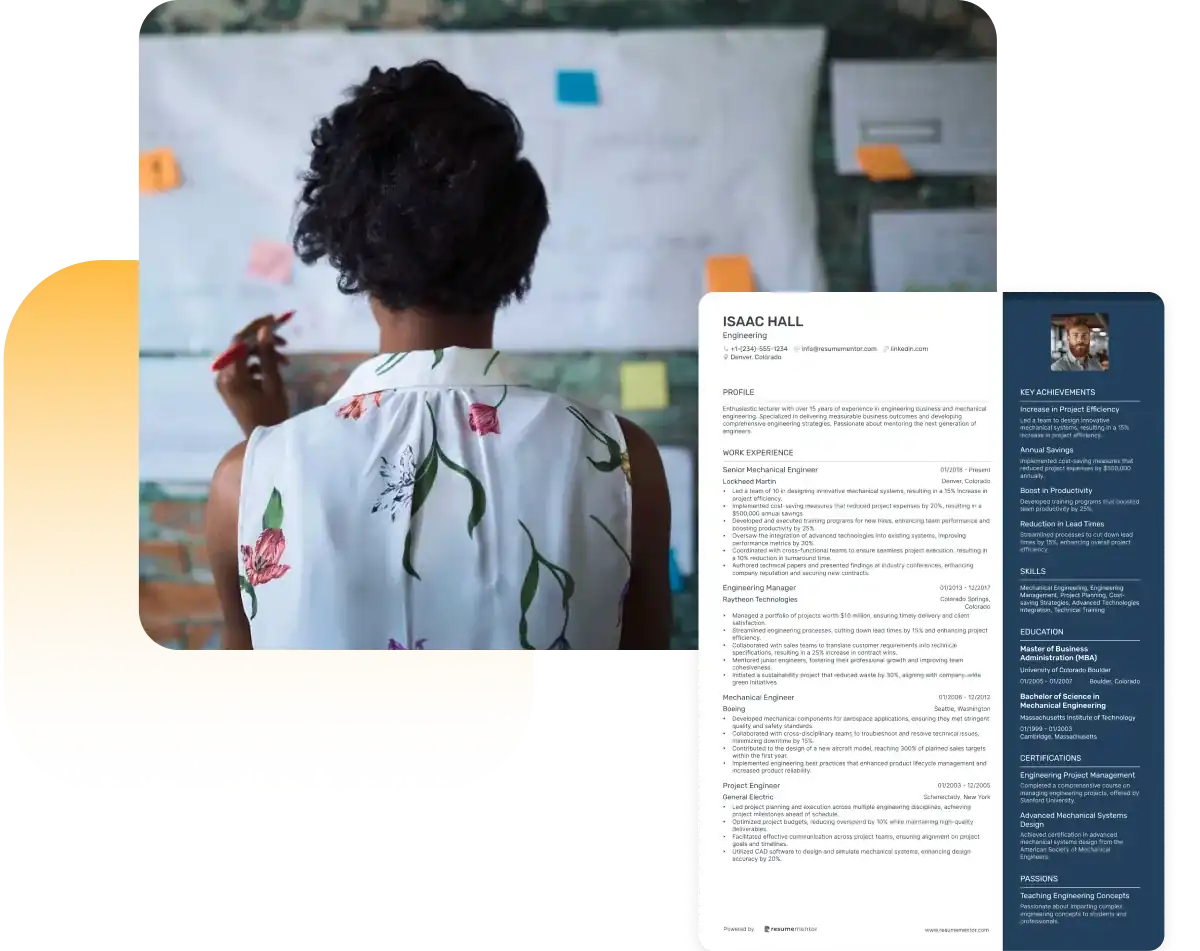
Continue Reading
Check more recommended readings to get the job of your dreams.
Resume
Resources
Tools
© 2025. All rights reserved.
Made with love by people who care.

